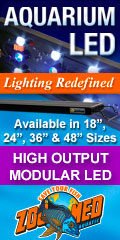**This is the official Aparicio ID Thread, please post pics of all your aparicios here. Please list size and sex. This if for ID purposes only, please do not post any comments**
Potamotrygon sp. "Aparico"
Common Names: Nazca Ray, Aparico Ray, Rio Tigre Motoro
Distribution: Rio Tigre, Peru
Maximum Size (Disc Width): appx. 24"+(?)
Juvenile Tank Footprint: 72"x18"
Adult Tank Footprint: 96"x36"
Feeding Habits: P. sp. "Aparico" tend to have good feeding habits. They usually accept live foods upon arrival, and wean to prepared foods easily. They can be aggressive feeders towards maturity.
Info: Potamotrygon sp. Aparico is not very often seen in the trade. Many believe they could be a wild hybrid, as they are not often available in high numbers. Their limited available increases value and no one has recorded a specimen over 20" thus far. They look very similiar to a hystrix in pattern, but body structure and regionality would likely classify this ray in the Motoro group. True P. cf. Hystrix do not migrate near this specimen, so it not likely to be hybridized with that species of stingray in the wild.
Potamotrygon sp. "Aparico"
Common Names: Nazca Ray, Aparico Ray, Rio Tigre Motoro
Distribution: Rio Tigre, Peru
Maximum Size (Disc Width): appx. 24"+(?)
Juvenile Tank Footprint: 72"x18"
Adult Tank Footprint: 96"x36"
Feeding Habits: P. sp. "Aparico" tend to have good feeding habits. They usually accept live foods upon arrival, and wean to prepared foods easily. They can be aggressive feeders towards maturity.
Info: Potamotrygon sp. Aparico is not very often seen in the trade. Many believe they could be a wild hybrid, as they are not often available in high numbers. Their limited available increases value and no one has recorded a specimen over 20" thus far. They look very similiar to a hystrix in pattern, but body structure and regionality would likely classify this ray in the Motoro group. True P. cf. Hystrix do not migrate near this specimen, so it not likely to be hybridized with that species of stingray in the wild.












